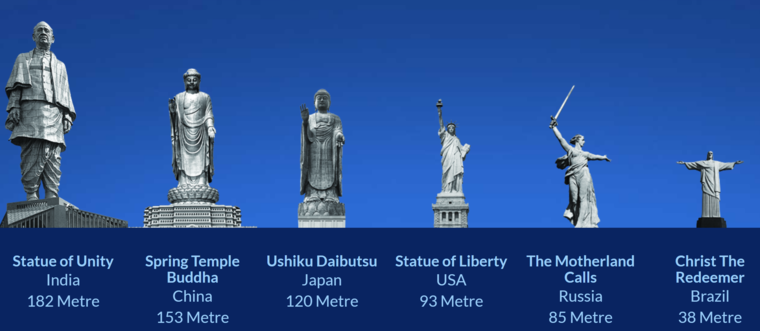Economy
A Towering Monument to India’s Road Not Taken

What does strongman showmanship look like? In India, it’s 25,000 tons of steel, 3,550 tons of bronze and 210,000 cubic meters of cement and concrete — towering over the world at a cost of about $400 million.
Prime Minister Narendra Modi recently unveiled the Statue of Unity in his home state of Gujarat. The likeness is of Sardar Vallabhbhai Patel, a leader of the independence movement known as the “Ironman of India,” who died in 1950. At 182 meters (597 feet), it’s the tallest such structure in the world — double the height of the Statue of Liberty and more than 40 percent higher than China’s Spring Temple Buddha.
At first blush, this ostentatious display of nationalism comes at the expense of other priorities. The cost was equivalent to around 90 percent of the central government’s annual budget for the skill development and entrepreneurship ministry; double that of the ministry of shipping; almost as much as the biotech department’s planned spending; and around 90 percent of the development expenditure budget for roads and bridges.
The amount could have irrigated 40,000 hectares of land, while all that cement and concrete could have been used to pave decrepit roads that cause thousands of deaths every year.
For all the things the statue didn’t do, it’s symbolic of the Modi government’s ability to push through spending on populist causes – even those that displace villages, sugarcane mills and farmers — while more urgent needs go unaddressed. Larsen & Toubro Ltd., India’s largest construction company, took less than three years to erect the statue. By comparison, China needed 11 years to construct its Buddha.
State-backed companies have shelled out funds through their corporate social responsibility departments to support the project, with gas giant GAIL India Ltd. and Oil India Ltd. each putting in about 250 million rupees ($3.4 million).
The efficiency of the government machinery stands in stark contrast to India’s modus operandi when it comes to infrastructure. Road projects have been stalled for years because of the government’s failure to help finance them. In recent months, companies such as Larsen & Toubro and IDFC Ltd. have reined in how much they spend on financing roads. Of 104 projects awarded, more than half don’t have enough money.
A public-private partnership metro project in the city of Hyderabad was “executed against huge odds,” Shailesh Pathak, CEO of L&T Infrastructure Development Projects, lamented on Twitter in September, adding that the company wouldn’t bid for any more PPP subway contracts.
A clogged financial system and the inability of banks to lend aggressively accounts partly for the backlog. Infrastructure project completion by the government and private sector in the fiscal second quarter fell more than 40 percent from a year earlier.
“This monument will not just be a mute memorial like the rest, but a fully functional, purpose-serving tribute,’’ the Statue of Unity’s website says, promising it will spur all sorts of socioeconomic development. That may be optimistic, given that an entrance ticket costs as much as an unskilled worker in Delhi earns in a day.
Still, at least it’s finished. India’s infrastructure could use a dose of the ironclad resolve that got this project done.
Continue Reading
-

 Leaders Speak2 months ago
Leaders Speak2 months agoDhofar International Development and Investment Company: Driving Sustainable Growth and Strategic Synergies in Oman’s Investment Landscape
-

 Economy1 month ago
Economy1 month agoMaal Card: What Oman’s New National Payment Card Means for Everyday Users
-

 Events2 months ago
Events2 months agoOER Corporate Excellence Awards 2025 Honours Entities and Innovations in Oman
-

 Arts and Culture2 months ago
Arts and Culture2 months agoOminvest and Bait Al Zubair Launch “Future Frames” to Empower Youth through Art and AI
-

 News1 month ago
News1 month agoSheikh Suhail Bahwan, Chairman of Suhail Bahwan Group, Passes Away
-

 Economy1 month ago
Economy1 month agoOman Unveils Official Omani Rial Symbol in Landmark Move to Boost Global Currency Presence
-

 News1 month ago
News1 month agoOIG Appoints New CEO to Lead Its Next Chapter of Excellence
-

 News4 weeks ago
News4 weeks agoReport: How India & The Middle East Are Exploiting Immense Economic Synergies





























You must be logged in to post a comment Login